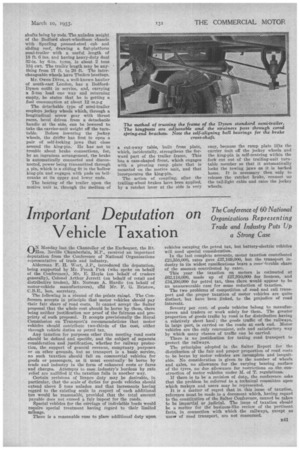Standardized Dyson tachable Carrier Units for
Page 58

Page 59

If you've noticed an error in this article please click here to report it so we can fix it.
Detachable and Non-deArticulated Six-wheelers
Semi-trailer Units Now Produced by a • • • AFTER long experience in trailer production, R. A. Dyson and Co., Ltd., 76-80, Grafton Street, Liverpool, S., now places on the market standardized models of two-wheeled carrier unit or semi-trailer for converting short-wheelbase motive units into
articulated .six-wheelers. Both detachable and non-detachable arrangements are available.
The frame consists of two steel channels, riveted, with gusset plates at top and bottom, to end channels, the latter being extended to the full width of the bodywork and connected longitudinally at their extremities by shaped wood members. A third wood longitudinal extends down the centre of the frame, midway between the channels. The forward cross-channel is curved at each end, forming, as it were, a continuation of the outer wood member. The floorboards are screwed down to the three wood longitudinal s and any of them can easily be removed.
The two channel longitudinals have flitch plates riveted to their vertical faces for the major part of theirlength, and, in order further to strengthen them against sagging, are trussed in a, clever
way. Adjustable king-posts are employed for the trussing, and a proper shackle anchoring is used at each end, go permitting flat bars to be adopted for the tension members. So that the front brackets for the rear springs may not necessitate shortening of the truss members, they are cored, and the flat bars passed through them. These , brackets carry self-aligning ball races for the brake cross-shafts, and are connected by tubular cross-members which take the side thrust. The spring pins are bushed and the pin heads are fixed against turning.
The well-known Dyson self-energizing type of brake is fitted to each trailing wheel, and on the 4-5-tonner
drums, giving about 200 square inches of friction surface, are the standard equipment. This model has springs 3 ins. wide and the brake reaction plate forms an integral steel casting with the axle -block. No cast iron is used throughout the design.
The front portion of the chassis frame is substantially braced by the turntable, which takes the form of a 4-in. by 2-iv. channel ring. This merely steadies the forecarriage, the main load being taken on spigoted bolster blocks held together by a square-sectioned spring. These bolsters also carry the shearing stress. of which the king-pin is, therefore, relieved—a good point in design.
An enclosed flexible cable affords the brake connection between motive unit and carrier, the final stage from the front of the carrier to the brake cam shafts being by rods. The unladen weight of the Bedford short-wheelbase chassis with Spurling pressed-steel cab and sliding roof, drawing a flat-platform semi-trailer with a useful length of 18 ft. fi ins, and having heavy-fluty dual 22-in. by 6-in. tyres, is about 2 tons 181t cwt. The trailer length may be anything from 17 ft. to 20 ft. The interchangeable wheels have Timken bearings.
Mr. Owen Dives, a well-known hauler of south-east London, has a BedfordDyson outfit in service, and, carrying a 5-ton load one way and returning empty, he states that he is getting a fuel consumption at about 12 m.p.g The detachable type of semi-trailer employs jockey wheels which, through a longitudinal screw gear with thrust races, bevel driven from a detachable handle at the side, can be lowered to take the carrier-unit weight off the turntable. Before lowering the jockey wheels, the driV'er has first to open a pair of self-locking jaws that close around the king-pin. He has not to trouble about brake connections, for, by an ingenious arrangement, the brake is automatically connected and disconnected, power being transmitted through a pin, which is a sliding fit in the hollow king-pin and engages with pads on bellcranks at its upper and lower ends.
The bearing of the trailer upon the motive unit is, through the Mediumof
a cut-away table, built from plate, which, incidentally, strengthens the forward part of the trailer frame. This has a cam-shaped front, which engages with a pivoting ramp plate that is mounted on the motive unit, and that incorporates the king-pin.
The action of coupling, after the trailing-wheel brakes have been applied, by a ratchet lever at the side is very easy, because the ramp plate lifts the carrier unit off the jockey wheels and the king-pin is self-centring within the fork cut out of the trailing-unit turntable member so that it automatically locks the towing jaws as it is backed home. It is necessary then only to release the ratchet brake, connect up the tail-light cable and raise the jockey wheels.






































































































